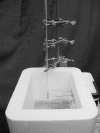The uncertainty (validity and reliability) of three electrothermometers in therapeutic modality research
- PMID: 16284643
- PMCID: PMC1250265
The uncertainty (validity and reliability) of three electrothermometers in therapeutic modality research
Abstract
Context: Data from electrothermometers are used to determine therapeutic modality usage, but the value of experimental results is only as good as the data collected.
Objective: To determine the reliability and validity of 3 electrothermometers from 2 manufacturers.
Design: A 3 x 4 x 17 factorial with repeated measures on 2 factors. Independent variables were trial (1, 2, 3), thermometer (mercury thermometer, Iso-Thermex calibrated from -50 degrees C to 50 degrees C, Iso-Thermex calibrated from -20 degrees C to 80 degrees C, and Datalogger), and time (17).
Setting: Human Performance Research Center.
Intervention(s): Eighteen thermocouples were inserted through the wall of a foamed polystyrene cooler, and 6 were connected to each of the 3 electrothermometers. The cooler was positioned on a stir plate and filled with room-temperature water (18.4 degrees C). A mercury thermometer was immersed into the water bath. Measurements of the water bath were taken every 10 seconds for three 3-minute trials.
Main outcome measure(s): The temperature variability of 3 electrothermometers was taken from a calibrated mercury thermometer.
Results: The Iso-Thermex electrothermometers did not differ statistically from each other in uncertainty (validity error +/- reliability error = 0.06 degrees C +/- 0.03 degrees C +/- 0.03 degrees C +/- 0.02 degrees C, P < .05), but both differed from the Datalogger (0.64 degrees C +/- 0.20 degrees C, P < .05). The Datalogger temperature was consistently higher than the mercury thermometer temperature.
Conclusions: The Iso-Thermex electrothermometers were more stable than the Datalogger, and values were within the published uncertainty (+/-0.1 degrees C) when used with PT-6 thermocouples. The Datalogger we used had an uncertainty of measurement greater than that indicated in the user's manual (approximately +/-0.52 degrees C). Uncertainty of +/-0.84 degrees C can significantly influence the interpretation of results when intramuscular temperature changes are usually less than 5 degrees C.
Figures



References
-
- Burr PO, Demchak TJ, Cordova ML, Ingersoll CD, Stone MB. Effects of altering intensity during 1-MHz ultrasound treatment on increasing triceps surae temperature. J Sport Rehabil. 2004;13:275–286.
-
- Gallo JA, Draper DO, Brody LT, Fellingham GW. A comparison of human muscle temperature increases during 3-MHz continuous and pulsed ultrasound with equivalent temporal average intensities. J Orthop Sports Phys Ther. 2004;34:395–401. - PubMed
-
- Merrick MA, Mihalyov MR, Roethemeier JL, Cordova ML, Ingersoll CD. A comparison of intramuscular temperatures during ultrasound treatments with coupling gel or gel pads. J Orthop Sports Phys Ther. 2002;32:216–220. - PubMed
LinkOut - more resources
Full Text Sources
